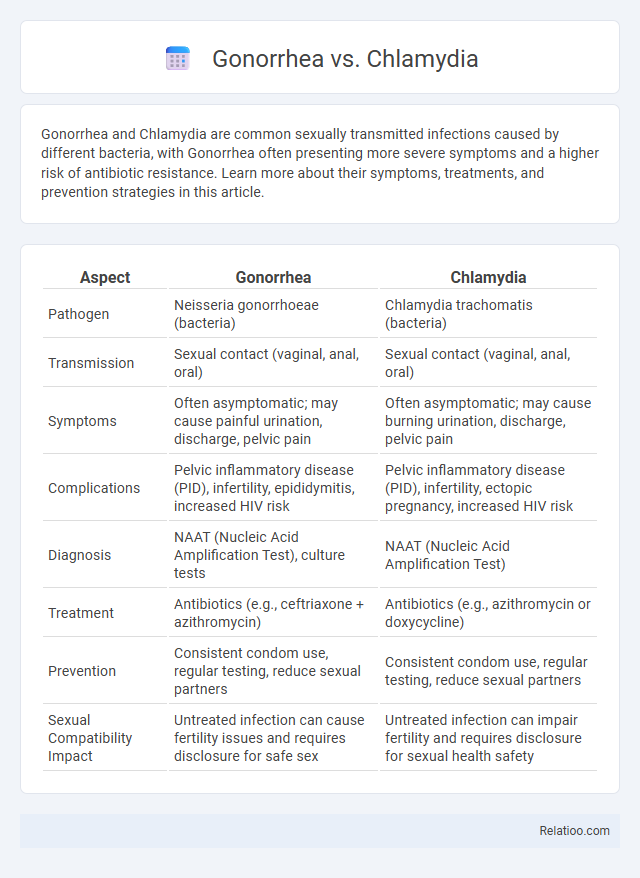Gonorrhea and Chlamydia are common sexually transmitted infections caused by different bacteria, with Gonorrhea often presenting more severe symptoms and a higher risk of antibiotic resistance. Learn more about their symptoms, treatments, and prevention strategies in this article.
Table of Comparison
| Aspect | Gonorrhea | Chlamydia |
|---|---|---|
| Pathogen | Neisseria gonorrhoeae (bacteria) | Chlamydia trachomatis (bacteria) |
| Transmission | Sexual contact (vaginal, anal, oral) | Sexual contact (vaginal, anal, oral) |
| Symptoms | Often asymptomatic; may cause painful urination, discharge, pelvic pain | Often asymptomatic; may cause burning urination, discharge, pelvic pain |
| Complications | Pelvic inflammatory disease (PID), infertility, epididymitis, increased HIV risk | Pelvic inflammatory disease (PID), infertility, ectopic pregnancy, increased HIV risk |
| Diagnosis | NAAT (Nucleic Acid Amplification Test), culture tests | NAAT (Nucleic Acid Amplification Test) |
| Treatment | Antibiotics (e.g., ceftriaxone + azithromycin) | Antibiotics (e.g., azithromycin or doxycycline) |
| Prevention | Consistent condom use, regular testing, reduce sexual partners | Consistent condom use, regular testing, reduce sexual partners |
| Sexual Compatibility Impact | Untreated infection can cause fertility issues and requires disclosure for safe sex | Untreated infection can impair fertility and requires disclosure for sexual health safety |
Overview: Understanding Gonorrhea and Chlamydia
Gonorrhea and chlamydia are two of the most common sexually transmitted infections (STIs) caused by bacteria Neisseria gonorrhoeae and Chlamydia trachomatis, respectively. Both infections primarily affect the genital tract but can also infect the throat and rectum, often presenting with mild or no symptoms, which increases the risk of transmission and complications such as pelvic inflammatory disease and infertility. Early diagnosis through nucleic acid amplification tests (NAATs) and timely antibiotic treatment are essential to control the spread and prevent long-term health consequences.
Causes and Transmission Pathways
Gonorrhea and chlamydia are both bacterial sexually transmitted infections primarily caused by Neisseria gonorrhoeae and Chlamydia trachomatis, respectively, transmitted through unprotected vaginal, anal, or oral sex. Both pathogens infect mucous membranes of the reproductive tract, including the cervix, urethra, rectum, and throat, facilitating direct person-to-person transmission via bodily fluids. Sexually transmitted infections broadly encompass various pathogens--bacterial, viral, and parasitic--spread through sexual contact, emphasizing the importance of barrier methods and regular screening to interrupt transmission pathways.
Common Symptoms and Signs
Gonorrhea and Chlamydia are both sexually transmitted infections (STIs) that often present with common symptoms such as painful urination, abnormal genital discharge, and pelvic pain. You may also experience itching, swelling, or sores in the genital area, though some cases remain asymptomatic, making testing crucial for detection. Recognizing these shared signs is vital for timely diagnosis and treatment to prevent complications.
Key Differences in Clinical Presentation
Gonorrhea often presents with purulent urethral discharge and dysuria, while Chlamydia frequently causes mild or asymptomatic infections with mucopurulent discharge. Both are common sexually transmitted infections (STIs), but Gonorrhea tends to have more acute symptoms compared to the subtler clinical signs of Chlamydia. Early diagnosis is crucial as untreated infections can lead to complications such as pelvic inflammatory disease or infertility.
Diagnostic Tests and Procedures
Gonorrhea and chlamydia are common sexually transmitted infections (STIs) diagnosed primarily through nucleic acid amplification tests (NAATs), which offer high sensitivity and specificity for detecting bacterial DNA or RNA. Diagnostic procedures often include urine samples or swabs from the affected sites such as the urethra, cervix, or throat, providing accurate results for both infections. Your healthcare provider may also recommend screening for other STIs during the testing process to ensure comprehensive diagnosis and treatment.
Complications and Long-Term Health Risks
Gonorrhea and chlamydia are both sexually transmitted infections (STIs) that can cause serious complications if untreated, including pelvic inflammatory disease (PID), infertility, and increased risk of ectopic pregnancy. Gonorrhea may also lead to disseminated gonococcal infection, causing joint pain and skin lesions, while chlamydia is often asymptomatic, increasing the risk of unnoticed damage to reproductive organs. Untreated STIs can elevate the risk of HIV transmission and cause chronic pelvic pain, highlighting the importance of early diagnosis and treatment to prevent long-term health risks.
Treatment Options and Medications
Gonorrhea treatment typically involves dual antibiotic therapy, such as ceftriaxone combined with azithromycin, to combat resistance and co-infection. Chlamydia is commonly treated with a single dose of azithromycin or a seven-day course of doxycycline, emphasizing adherence to complete medication for effective eradication. Sexually transmitted infections (STIs) encompass various pathogens requiring tailored antimicrobial regimens, with early diagnosis and appropriate antibiotic use crucial for preventing complications and transmission.
Prevention Strategies and Safer Sex Practices
Consistent and correct condom use remains the most effective prevention strategy against Gonorrhea, Chlamydia, and other sexually transmitted infections (STIs), reducing transmission risk by up to 98%. Regular STI screenings and timely treatment are crucial for early detection and interruption of infection chains, especially since both Gonorrhea and Chlamydia can be asymptomatic. Limiting the number of sexual partners and engaging in mutually monogamous relationships with tested partners further decreases the likelihood of STI transmission.
The Importance of Early Detection and Screening
Early detection and screening of gonorrhea, chlamydia, and other sexually transmitted infections (STIs) are crucial for preventing severe health complications such as pelvic inflammatory disease, infertility, and increased HIV risk. Regular testing helps identify asymptomatic infections, allowing timely treatment that reduces transmission and protects your sexual health. Prioritizing routine STI screening empowers you to maintain overall wellness and supports public health efforts to control infection spread.
Frequently Asked Questions about Gonorrhea and Chlamydia
Gonorrhea and chlamydia are common sexually transmitted infections (STIs) caused by different bacteria: Neisseria gonorrhoeae and Chlamydia trachomatis, respectively. Frequently asked questions often address symptoms such as painful urination and unusual discharge, modes of transmission, testing methods including nucleic acid amplification tests (NAATs), and effective antibiotic treatments like azithromycin or doxycycline for chlamydia and ceftriaxone for gonorrhea. Understanding differences in complications, such as pelvic inflammatory disease (PID) in untreated cases, highlights the importance of prompt diagnosis and regular STI screening.

Infographic: Gonorrhea vs Chlamydia
 relatioo.com
relatioo.com